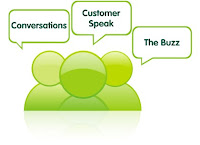As Radian6's social
monitoring package starts (according to their website) at $600/month* to cover only 1 topic profile (see http://bit.ly/nLXHFK) and as much as $10,000/month for a
‘Pro’ account (to hear a mouse fart) – you really need to ask yourself whether your
brand actually requires that level of engagement.
Unless you’re a brand with a significant need to 'frame' and direct discussions - someone like Nestle or Monsanto for example (recently voted “2011’s Most Evil Corporation of the Year”) - you'll be happy to know that there are any number of Social Monitoring Tools that will meet your needs. Note: Be mindful to choose at least one overarching tool that monitors multiple types of social media. Here is the beginning of what we hope will be a growing list of (free) monitoring resources, so if you stumble across a new free social monitoring tools (that aren’t trials or limited time offers) please forward to info@goodbuzz.ca.
Unless you’re a brand with a significant need to 'frame' and direct discussions - someone like Nestle or Monsanto for example (recently voted “2011’s Most Evil Corporation of the Year”) - you'll be happy to know that there are any number of Social Monitoring Tools that will meet your needs. Note: Be mindful to choose at least one overarching tool that monitors multiple types of social media. Here is the beginning of what we hope will be a growing list of (free) monitoring resources, so if you stumble across a new free social monitoring tools (that aren’t trials or limited time offers) please forward to info@goodbuzz.ca.
Social Mention – As the title implies, SM tracks
and measures what is being said about a specific topic in real time across more
than 100 social media services. While Social Mention may appear to allow the
setting up of alerts, the functionality hasn't been available for nearly a year. Still a solid real-time social search algorithm that measures sentiment (positive, neutral, negative) as well.
MonitorThis – Allows you
to search for brand mentions in 25 different search engines, however doesn’t
appear to support alerts.
WhosTalkin.com - The search and sorting
algorithms combine data taken from over 60 of the internet's most popular
social media gateways (however also doesn’t appear to support alerts.) Also, check out IceRocket and Alltop
Facebook
Search as a Facebook specific monitoring tool. Openbook
may also be useful in turning up mentions of your brand in Facebook status
updates.
Addict-o-matic lets you instantly create a custom page with the latest buzz on a given topic. The browser-based tool offers a one-stop customized site for seeing results across multiple social media channels.
Addict-o-matic lets you instantly create a custom page with the latest buzz on a given topic. The browser-based tool offers a one-stop customized site for seeing results across multiple social media channels.
Guzzle reads hundreds of feeds on social media sites every second to help you keep abreast of stuff you care about.
Buzzoo is a buzz aggregator drawing from
multiple sources.
BuzzFeed sports a robust buzz-detection algorithm.
Twendz piggybacks off Twitter Search to offer user sentiment in real
time.
Social Seek will tell you
who’s making the most noise about your brand.
Mon.itor.us is a free website, server and
traffic monitoring service.
Keotag lets you search multiple search engines, create social bookmark links around a topic or see who has used your brand as a tag.
Comment Sniper lets be the first to
comment on relevant blog posts about your brand or sector. You set up blogs you
want to monitor, and Comment Sniper sends you a desktop notification or text
message to your mobile device whenever a new post goes up.
coComment is a Web service and Firefox
plug-in that helps you keep track of blog comment threads. Whenever
there is an update, such as a new follow-up comment, coComment notifies you
instantly. It’s a handy service that saves you the trouble of checking back on
blogs that don’t offer a comment notification feature.
Commentful is another Web service that
helps you keep track of blog comments.
Omgili (Oh my God I love it) forum search engine lets you find communities, message boards and discussion threads about any topic.
co.mments helps you keep track of conversations.
Boardtracker, Big Boards, and Yuku Find crawl forums, blog posts, images and microblogs. They'll also
let you know when a new forum starts specifically to discuss your brand or
organization.
WatchThatPage - Keeps a watchful eye when
updates take place to an important Web page — say, your Wikipedia page or key
pages on your competitors’ sites. Instruct WatchThatPage to keep tabs on any Web
page, and you’ll receive an alert any time a change is made to the page.
Google Alerts - One of the easiest and
most popular of free monitoring services, Google Alerts are notifications of
(customizable) new results on up to 1000 search terms. As the name implies, alerts can be set
up.
When you marry this with Google Trends (which compares how
frequently searches have been made on up to five topics over time) you can
unearth a great deal of insight. Social media monitoring begins with a
dashboard.
A good choice to begin
your monitoring is Google Reader:
Subscribe to the RSS feeds of top blogs in your sector, competitors’ sites,
news sites, Twitter searches and more, all in one place. You can even subscribe
to searches on sites like Flickr and YouTube, so you’ll get an update on any
new image or video that matches your brand or cause. Finally, Google Realtime Search, lets you search
the social Web (chiefly Twitter) and create email alerts for search terms. Also
don’t forget Google
Advanced Blog Search
As we mentioned, here is the beginning of what we hope will be a growing list of (free) monitoring resources, so if you stumble across a new free social monitoring tools (that aren’t trials or limited time offers) please forward to info@goodbuzz.ca.





.jpg)




